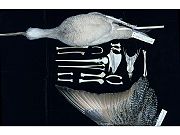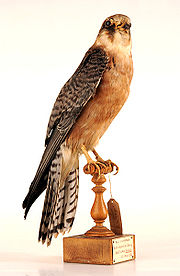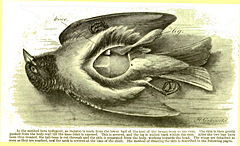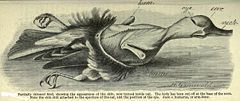
Bird collections
Encyclopedia

Specimen
A specimen is a portion/quantity of material for use in testing, examination, or study.BiologyA laboratory specimen is an individual animal, part of an animal, a plant, part of a plant, or a microorganism, used as a representative to study the properties of the whole population of that species or...
s consisting of birds and their parts. They are a research resource for ornithology
Ornithology
Ornithology is a branch of zoology that concerns the study of birds. Several aspects of ornithology differ from related disciplines, due partly to the high visibility and the aesthetic appeal of birds...
, the science of birds, and for other scientific disciplines in which information about birds is useful. These collections are archives of avian diversity and serve the diverse needs of scientific researchers, artists, and educators.
Collections may include a variety of preparation types emphasizing preservation of feathers, skeletons, soft tissue
Soft tissue
In anatomy, the term soft tissue refers to tissues that connect, support, or surround other structures and organs of the body, not being bone. Soft tissue includes tendons, ligaments, fascia, skin, fibrous tissues, fat, and synovial membranes , and muscles, nerves and blood vessels .It is sometimes...
s, or (increasingly) some combination thereof. Modern collections range in size from small teaching collections, such as one might find at a nature reserve visitor center or small college, to large research collections of the world’s major natural history museums, the
largest of which contain hundreds of thousands of specimens. Bird collections function much like libraries, with specimens arranged in drawers and cabinets in taxon
Taxon
|thumb|270px|[[African elephants]] form a widely-accepted taxon, the [[genus]] LoxodontaA taxon is a group of organisms, which a taxonomist adjudges to be a unit. Usually a taxon is given a name and a rank, although neither is a requirement...
omic order, curated by scientists who oversee the maintenance, use, and growth of collections and make them available for study through visits or loans.
Origin

collect and display natural curiosities in Victorian England. Some wealthy cabinet naturalists were able to amass large collections using networks of field collectors. These early collections were not intended for scientific study and the collectors gave importance to aesthetics rather than scientific value. It grew into a more scientific pursuit much later.
Growth
Early scientific bird collections included those belonging to PallasPeter Simon Pallas
Peter Simon Pallas was a German zoologist and botanist who worked in Russia.- Life and work :Pallas was born in Berlin, the son of Professor of Surgery Simon Pallas. He studied with private tutors and took an interest in natural history, later attending the University of Halle and the University...
and Naumann
Johann Friedrich Naumann
Johann Friedrich Naumann was a German scientist and editor.Naumann is regarded as the founder of scientific ornithology in Europe...
in Germany, Latham
John Latham (ornithologist)
John Latham was an English physician, naturalist and author. He was born at Eltham in Kent, and was the eldest son of John Latham, a surgeon there, and his mother was a descendant of the Sothebys, in Yorkshire....
and Tunstall
Marmaduke Tunstall
Marmaduke Tunstall was an English ornithologist and collector. He was the author of Ornithologica Britannica , probably the first British work to use binomial nomenclature....
in England and Adanson
Michel Adanson
Michel Adanson was a French naturalist of Scottish descent.Adanson was born at Aix-en-Provence. His family moved to Paris on 1730. After leaving the College Sainte Barbe he was employed in the cabinets of R. A. F. Reaumur and Bernard de Jussieu, as well as in the Jardin des Plantes. At the end of...
in France. Collections grew in size with increasing maritime activity, exploration and colonialism. For example, Charles Darwin
Charles Darwin
Charles Robert Darwin FRS was an English naturalist. He established that all species of life have descended over time from common ancestry, and proposed the scientific theory that this branching pattern of evolution resulted from a process that he called natural selection.He published his theory...
collected over 400 bird specimens during his travels on the Beagle, and it was many years after his return to England that his bird collections from the Galapagos inspired (in part) his theory of evolution
Evolution
Evolution is any change across successive generations in the heritable characteristics of biological populations. Evolutionary processes give rise to diversity at every level of biological organisation, including species, individual organisms and molecules such as DNA and proteins.Life on Earth...
through natural selection
Natural selection
Natural selection is the nonrandom process by which biologic traits become either more or less common in a population as a function of differential reproduction of their bearers. It is a key mechanism of evolution....
. The Paris museum had 463 bird specimens in 1793 and this grew to 3411 in 1809; The Berlin museum had 2000 specimens in 1813 growing to 13,760 around 1850. The scale of collections grew to the point where they needed more space and full-time curators. In the earliest days of ornithology, collecting was the dominant method of bird observation and study. This approach has diminished with the growth of the discipline. The use of mist-netting
Mist net
Mist nets are used by ornithologists and bat biologists to capture wild birds and bats for banding or other research projects. Mist nets are typically made of nylon mesh suspended between two poles, resembling an oversized volleyball net. When properly deployed, the nets are virtually invisible...
and photography, blood sampling (for DNA, immunological and other studies), the development of optics and the use of other new techniques for studying birds have reduced the need to collect specimens for research, yet collections continue to act as a vital shared resource for science (particularly taxonomy) and conservation. In an era of mass extinction, bird collections will evidence lost species.
Collection and preservation techniques

Cat
The cat , also known as the domestic cat or housecat to distinguish it from other felids and felines, is a small, usually furry, domesticated, carnivorous mammal that is valued by humans for its companionship and for its ability to hunt vermin and household pests...
s, by-catch
By-catch
The term “bycatch” is usually used for fish caught unintentionally in a fishery while intending to catch other fish. It may however also indicate untargeted catch in other forms of animal harvesting or collecting...
from fisheries, die-offs from disease, vehicle strikes, and other accidental sources of mortality. However, the world's bird collections have been argued to be inadequate in documenting avian diversity, from taxonomic, geographic, and temporal perspectives, with some parts of tropical regions considered under-represented in particular museums. Underrepresented taxa continue to be actively collected by ornithologists, generally using either firearms or mist-nets. Permitting agencies oversee these activities in most countries.


Royal Ontario Museum
The Royal Ontario Museum is a museum of world culture and natural history in Toronto, Ontario, Canada. With its main entrance facing Bloor Street in Downtown Toronto, the museum is situated north of Queen's Park and east of Philosopher's Walk in the University of Toronto...
removes all bones for a complete skeleton while also producing a round skin without bill or legs (called a ROM, though if one set of wing and leg bones remain with the skin the preparation is called a shmoo in North America). Alternatively, the entire bird (or any soft parts associated with preparations described above) may be preserved in alcohol. For any of these methods, several supplemental preparations may be made. For example, a wing may be removed and preserved separately as a spread wing for better study of flight feathers; a tissue sample may be removed and frozen for molecular analyses; or a recording of the bird's song before collection may be archived. Neither molecular samples nor sound recordings require a bird to be collected (killed). Finally, if the bird is too rotten for the skin and feathers to be preserved, as is the case with some salvaged specimens, the skeleton alone may be preserved. Dried tissue is removed from skeletons by using dermestid beetle larvae (genus Dermestes
Dermestes
Dermestes is a genus of larder beetles in the family Dermestidae. Both the adult beetles and the larvae feed on dry dead animals and vegetable material. Dermestes, especially its larvae, can seriously damage natural animal fibers, foodstuff, furnishing and zoological collections...
). Whereas in the past arsenic was routinely added to skins to protect them from destruction by insects, specimens prepared today are generally protected by an initial freezing period to kill insects and their eggs followed by keeping them in high-quality museum cases in a climate-controlled room. Each specimen has data associated with it, and the amount of data available is usually directly correlated with the specimen’s scientific value. Most specimens are of little value for research without accompanying information, such as the time and place the bird was found or collected. This and other important information, such as mass, sex, fat deposition, and degree of skull ossification
Ossification
Ossification is the process of laying down new bone material by cells called osteoblasts. It is synonymous with bone tissue formation...
, is written on a label along with a unique field and museum number. Modern computerized museum databases include all of this information for each specimen, as well as the types of methods used to prepare the bird. Modern collections seek to maximize the utility of each preserved individual, and this includes recording detailed information about it. Most modern specimens also include a tissue sample preserved for genetic study. Online access to collections’ data is becoming increasingly available, and a cross-institutional database covering millions of computerized bird records is in development.
Uses of bird collections
Bird collections are used for a wide variety of purposes. All biological speciesSpecies
In biology, a species is one of the basic units of biological classification and a taxonomic rank. A species is often defined as a group of organisms capable of interbreeding and producing fertile offspring. While in many cases this definition is adequate, more precise or differing measures are...
including those of birds are represented by a holotype
Holotype
A holotype is a single physical example of an organism, known to have been used when the species was formally described. It is either the single such physical example or one of several such, but explicitly designated as the holotype...
, the vast majority of which are full specimens (mostly skins) and in modern times explicitly designated in the original description of the taxon
Taxon
|thumb|270px|[[African elephants]] form a widely-accepted taxon, the [[genus]] LoxodontaA taxon is a group of organisms, which a taxonomist adjudges to be a unit. Usually a taxon is given a name and a rank, although neither is a requirement...
. All other putative members of the species may be compared to the holotype to confirm their identification. Rigorous studies of avian taxonomy
Taxonomy
Taxonomy is the science of identifying and naming species, and arranging them into a classification. The field of taxonomy, sometimes referred to as "biological taxonomy", revolves around the description and use of taxonomic units, known as taxa...
are based on specimens from bird collections. Taxonomic studies rely on unique similarities in morphological and genetic characters to determine species limits and evolutionary relationships. Museum specimens have been the preferred source for scoring these characteristics, as they provide a method for allowing studies to be replicated – anyone may go back and repeat the study using the same specimens to verify the conclusions.
In the case of molecular studies, the preservation of a specimen that can vouch for the source of the tissue sample used to gather genetic data has been recommended, as genetic analysis often yields surprising results that make reexamination of the original specimen crucial.
Studies on ectoparasites
Parasitism
Parasitism is a type of symbiotic relationship between organisms of different species where one organism, the parasite, benefits at the expense of the other, the host. Traditionally parasite referred to organisms with lifestages that needed more than one host . These are now called macroparasites...
, usually obtained during capture, but also obtained from old museum specimens, are valuable for studies on coevolution and zoonoses
Zoonosis
A zoonosis or zoonoseis any infectious disease that can be transmitted from non-human animals to humans or from humans to non-human animals . In a study of 1415 pathogens known to affect humans, 61% were zoonotic...
. However, it has alternatively been argued that such re-examimation can be undertaken from archived photographs without killing the study piece.
In addition to taxonomic research, collections can provide information relevant to the study of variety of other ornithological questions, including comparative anatomy
Comparative anatomy
Comparative anatomy is the study of similarities and differences in the anatomy of organisms. It is closely related to evolutionary biology and phylogeny .-Description:...
, ecology
Ecology
Ecology is the scientific study of the relations that living organisms have with respect to each other and their natural environment. Variables of interest to ecologists include the composition, distribution, amount , number, and changing states of organisms within and among ecosystems...
, behavior
Behavior
Behavior or behaviour refers to the actions and mannerisms made by organisms, systems, or artificial entities in conjunction with its environment, which includes the other systems or organisms around as well as the physical environment...
, disease
Disease
A disease is an abnormal condition affecting the body of an organism. It is often construed to be a medical condition associated with specific symptoms and signs. It may be caused by external factors, such as infectious disease, or it may be caused by internal dysfunctions, such as autoimmune...
, and conservation
Wildlife conservation
Wildlife conservation is the preservation, protection, or restoration of wildlife and their environment, especially in relation to endangered and vulnerable species. All living non-domesticated animals, even if bred, hatched or born in captivity, are considered wild animals. Wildlife represents all...
. Forensic ornithologists use collections to identify species involved in aircraft bird strike
Bird strike
A bird strike—sometimes called birdstrike, avian ingestion , bird hit, or BASH —is a collision between an airborne animal and a man-made vehicle, especially aircraft...
s, imported materials containing bird parts, and birds killed through various human activities, legal and illegal. In addition, collections are used by zooarchaeologists
Zooarchaeology
Zooarchaeology, also known as Archaeozoology, is the study of animal remains from archaeological sites. The remains consist primarily of the hard parts of the body such as bones, teeth, and shells...
to identify bird bones at prehistoric human sites or species of origin for feathers used in human cultural artifacts
Artifact (archaeology)
An artifact or artefact is "something made or given shape by man, such as a tool or a work of art, esp an object of archaeological interest"...
. Collections also have been heavily used by artists, particularly for the production of plates for ornithological field guide
Field guide
A field guide is a book designed to help the reader identify wildlife or other objects of natural occurrence . It is generally designed to be brought into the 'field' or local area where such objects exist to help distinguish between similar objects...
s. The close-up observation and opportunity for manipulation provided by preserved study skins makes them, together with field observations and photography, to be an important basis for painters of field guide plates of birds. Most bird species have several unique plumages that distinguish immature from adults, males from females, and breeders from non-breeders. Thus, many different specimens may be required to produce a thorough plate for identification of a given species. Accurate colour measurements using spectrometry are possible from specimens.
Bird collections are becoming increasingly important for use in retrospective studies. Bird collections offer the scientists of today their single opportunity for in-depth morphological and molecular study of past avian diversity. One of the earliest and most famous examples of this was the use of egg collections from the 19th and early 20th centuries in determining that the pesticide DDT
DDT
DDT is one of the most well-known synthetic insecticides. It is a chemical with a long, unique, and controversial history....
was producing eggshell-thinning in raptors. The ornithologists who collected the eggs could never have known that their work would one day help rescue several raptors from possible extinction.
As threats to bird populations grow and extinctions continue, historical specimens are valuable in documenting the impacts of human activities and causes of decline for threatened species. Other possible uses for bird specimens not known today may arise in the future.
Collection debates
The issue of whether birds should continue to be actively collected for research has been the subject of some debate among ornithologists (examples of this can be found in the lively exchanges between Remsen and Bekoff & Elzanowski, between Vuilleumier and Donegan and between Dubois & Nemesio and Donegan).Those opposed to collecting believe that much of current collecting is unnecessary, arguably motivated by the personal field scores of individuals or by competition between museums, rather than the result of a strict scientific rationale; that collecting, in extreme cases of species on the verge of extinction, can pose a threat to bird populations; and that in many cases in which the necessity of specimens is claimed, new technology such as digital photography and blood sample analysis of mist-netted individuals could instead be used. Finally, at a time of rampant deforestation and species extinctions, scientists and conservationists should take the lead in providing an example to local people not to kill or hunt birds. Where other techniques not involving killing of a bird are feasible, to take a specimen is viewed by some as simply unethical. Proponents of collecting counter-argue that compared to the many millions of birds killed each year by habitat destruction, domestic cats, window strikes, and tower kills, scientists collect only a few thousand birds per year worldwide and populations will quickly recover from an episode of collecting as long as their habitat remains. Supporters of continued collecting also point to the greater scientific utility and legacy of museum specimens compared to blood samples or photographs, and argue that collecting for research offers the only source of avian mortality with a positive outcome for birds in terms of the biological knowledge gained. Although taking small blood samples from wild birds is often viewed as a harmless alternative to collecting, it reduces survival by as much as 33% and does not provide the benefits of a voucher specimen. Scientists have pointed out that bird populations represent renewable resources, and that scientific collecting represents only a tiny and non-additive proportion of annual bird mortality. However, examples exist of species whose extinction was directly contributed to by museum collecting (e.g. Guadalupe Caracara
Guadalupe Caracara
The Guadalupe Caracara, Caracara lutosa, is an extinct bird of prey belonging to the falcon family . It was, together with the closely related Crested and Southern Caracara, formerly placed in the genus Polyborus. It was also known as the Quelili or the Calalie.This species inhabited Mexico's...
, Ivory-billed Woodpecker
Ivory-billed Woodpecker
The Ivory-billed Woodpecker is or was one of the largest woodpeckers in the world, at roughly 20 inches in length and 30 inches in wingspan. It was native to the virgin forests of the southeastern United States...
).

